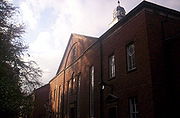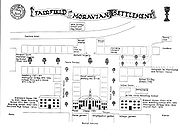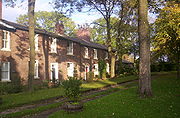
Fairfield Moravian Church
Encyclopedia

Droylsden
Droylsden is a town within the Metropolitan Borough of Tameside, in Greater Manchester, England. It is to the east of Manchester city centre, and west-southwest of Ashton-under-Lyne, it has a population of 23,172....
, part of the Metropolitan Borough of Tameside
Tameside
The Metropolitan Borough of Tameside is a metropolitan borough of Greater Manchester in North West England. It is named after the River Tame which flows through the borough and spans the towns of Ashton-under-Lyne, Audenshaw, Denton, Droylsden, Dukinfield, Hyde, Mossley and Stalybridge. Its western...
, Greater Manchester
Greater Manchester
Greater Manchester is a metropolitan county in North West England, with a population of 2.6 million. It encompasses one of the largest metropolitan areas in the United Kingdom and comprises ten metropolitan boroughs: Bolton, Bury, Oldham, Rochdale, Stockport, Tameside, Trafford, Wigan, and the...
, England.
Foundation of the settlement
In 1742 the Moravians established a headquarters for their evangelistic work in the North of England at LightcliffeLightcliffe
Lightcliffe is a village in West Yorkshire, England.Situated approximately three miles east of Halifax in the metropolitan district of Calderdale....
near Halifax in Yorkshire. At the request of James Taylor and John Wood of Cheshire, evangelists moved to work in the Manchester area. In 1751 a congregation was established in Dukinfield
Dukinfield
Dukinfield is a small town within the Metropolitan Borough of Tameside, in Greater Manchester, England. It lies in central Tameside on the south bank of the River Tame, opposite Ashton-under-Lyne, and is east of the city of Manchester...
, Cheshire
Cheshire
Cheshire is a ceremonial county in North West England. Cheshire's county town is the city of Chester, although its largest town is Warrington. Other major towns include Widnes, Congleton, Crewe, Ellesmere Port, Runcorn, Macclesfield, Winsford, Northwich, and Wilmslow...
, with a small settlement following there in 1755. This was to be the centre of a preaching mission on the western side of the Pennines. However, there was limited scope for expansion at Dukinfield and in 1783 the Moravians purchased sixty acres of land in Droylsden on a 999 years lease from a Mrs Greaves at Broad Oaks Farm and from her neighbours, Mr Saxon and Mr Kirkenhead. This was to become Fairfield Moravian Settlement.
The architect of the new settlement was a member of the Moravian Church, Br John Lees, who came from Clarksfield, Oldham
Oldham
Oldham is a large town in Greater Manchester, England. It lies amid the Pennines on elevated ground between the rivers Irk and Medlock, south-southeast of Rochdale, and northeast of the city of Manchester...
. There is some evidence that Br Lees, who was a businessman, may have sold two coal mines in his possession to help pay for the expenses of building Fairfield. Other finance came from Moravian congregations in England, Germany and America. The cost was £6,000 in total.

Augsburg Confession
The Augsburg Confession, also known as the "Augustana" from its Latin name, Confessio Augustana, is the primary confession of faith of the Lutheran Church and one of the most important documents of the Lutheran reformation...
contained the core doctrines of the Lutheran Church, by which the Moravians had been much influenced during their time of renewal at Herrnhut
Herrnhut
Herrnhut is a municipality in the district of Görlitz, in the Free State of Saxony, Germany.It has access to Bundesstraße 178 between Löbau and Zittau...
on the estates of Count Nicolas Ludwig von Zinzendorf in Saxony, Germany in the 1720s.)
By May 1785, the ‘choir houses’ and thirteen dwelling houses were completed and tenanted. It was a feature of Moravian settlement life in the eighteenth and early nineteenth centuries that members were grouped into three choirs (i.e., communities): married; single brothers; and single sisters. The single brethren would occupy shared accommodation and also work together within the settlement as would the single sisters in their house.
Consecration
The chapel was consecrated in a private service on 15 July 1785. On this occasion, a new single sister from Oldham was received into the congregation and Br Joshua Sutcliffe was ordained deacon by Bishop Tranaker. The bishop had travelled over from the Fulneck settlement in Yorkshire for the occasion.The public opening of the chapel took place on Sunday 17 July. Some 1,500 people attended Morning Service. This began with a ‘musical ode’ performed on the new organ by Br Christian La Trobe supported by the united brass bands of Fulneck and Fairfield. (The use of brass instruments in worship is a Moravian characteristic now largely defunct in England but alive in Germany and the United States.) Br Benjamin La Trobe preached a sermon on Matthew 28: 19-30 in a service lasting over three hours.
Benjamin La Trobe, of Huguenot
Huguenot
The Huguenots were members of the Protestant Reformed Church of France during the 16th and 17th centuries. Since the 17th century, people who formerly would have been called Huguenots have instead simply been called French Protestants, a title suggested by their German co-religionists, the...
descent, was the ‘Provincial Helper’ or superintendent in charge of the Moravian work in the United Kingdom, reporting back to the Unity (i.e., international) Headquarters in Herrnhut, Germany. La Trobe’s son, Benjamin Henry Latrobe, went on to be Architect of the Capitol of the United States in Washington, DC.
Settlement life
In 1785, membership at Fairfield stood at 110 souls. Twenty two men lived in the Single Brethren’s House and forty five women in the Single Sisters’ House.The congregation was overseen by an Elders Conference consisting of the Minister and his wife, the Single Brethren’s Labourer, the Single Sisters’ Labouress, a member of the Married Choir and, later, two elected representatives of the congregation. In turn, the Elders appointed a College of Overseers to manage the settlement. This dealt with repair of buildings, maintenance of roads, street lighting and supervision of economic activity.
Economic activities included weaving, baking, and saddlery by the single brethren; an inn (which was closed in 1848 because of drunkenness and reopened as a hostel in 1861); and a farm, laundry and needlework shop by the single sisters. The settlement also maintained and operated its own fire engine. Later activities included brickmaking and cotton carding and spinning.
The Single Brethren's House was not a success financially. Moreover, the young men had to be admonished many times for drinking too much at the settlement's inn; on one occasion, they appear to have had some fun at a fire drill by turning the hosepipe on a Br Gilpin who unfortunately took offence.
In the eighteenth century, the chapel was called the ‘hall’. It was unlit and unheated. Hard benches surrounded a pulpit and communion table in the centre of the north wall. The sisters sat on the east side of the hall, near their House; and the brethren on the west side, next to theirs. When the Married choir came to church, the men sat with the single brethren and the women with the sisters. This practice continued until late in the nineteenth century. On the wall opposite the pulpit, there was a gallery with an organ in it; and a musical choir assembled there to sing the responses in the liturgy.
The Lot
The Fairfield congregation used the LotCleromancy
Cleromancy is a form of divination using sortition, casting of lots, or casting bones or stones, in which an outcome is determined by means that normally would be considered random, such as the rolling of dice, but are sometimes believed to reveal the will of God, or other supernatural entities.-In...
when taking major decisions. These decisions included admission to membership and choice of a marriage partner. Following prayer and the posing of the question, the Lot was consulted by drawing at random one of three slips of paper. One slip would be marked Yes, one No and one was blank. The practice was based on biblical precedent and reflected the strong Moravian belief in Christ as the active and directing Head of the Church.
By 1815 the use of the Lot to determine membership had begun to wane. This may have been partly due to a harsh result on 8 May 1815 when a married woman, Hannah Kenyon, earnestly sought on her death bed to become a member of Fairfield. The Elders were satisfied that Hannah was sincere and nobody in the congregation had any objection; but the Lot said No.
Records show that in 1803 and again in 1810 six marriages were arranged by the Elders and confirmed by Lot. Anyone marrying outside of the congregation was asked to leave. However, by 1820 the use of the Lot to choose wives (it seems always to have been the Brethren who initiated proceedings) was also fading. It was retained for some more years for Ministers and pastoral Labourers. As late as 1822, the 'Unity Elders sought a wife for a Br Light who was serving in Jamaica. Sr Mary Savile was thought of at Fairfield and chosen by Lot to which when informed, she accepted and ... sailed for Jamaica'.
God's Acre
A burial ground known as 'God's AcreGod's Acre
God's Acre is an ancient Germanic designation for a burial ground. In his poem "God's-Acre," Henry Wadsworth Longfellow attributes the term to ancient Saxons.-In Christianity:...
', surrounded by quickset hedges, was established in front of the church beyond a row of gardens. The congregation provided small uniform gravestones which lay flat on the earth, bearing only the name and age of the departed. This was an expression of the equality of brothers and sisters. Initially, the two sexes were buried separately in a post mortem continuation of the choir system. The sundial in the graveyard bore the motto, 'I die today, I live tomorrow'. Mourning was not encouraged and corpses were led to the grave by a choir of brass instruments as well as the Minister. At a sunrise service
Sunrise service
Sunrise service is a worship service on Easter. It takes the place of the Roman Catholic, Eastern Orthodox, Anglican, and Lutheran tradition of the Easter Vigil, and is practised mainly by Protestant churches...
on Easter
Easter
Easter is the central feast in the Christian liturgical year. According to the Canonical gospels, Jesus rose from the dead on the third day after his crucifixion. His resurrection is celebrated on Easter Day or Easter Sunday...
Sunday the congregation would meet in God's Acre to rejoice in the Resurrection. This remains the custom of the Moravian Church.

Schools
A boarding school was established for girls in 1796 and another for boys in 1802. The boys’ school closed in 1891 and the girls’ in 1919. The girls' school became Fairfield High School.Mission
The impulse of the Moravian Church following its renewal at Herrnhut was to evangelise. This did not entail proselytising from other churches. Rather, it involved two things: creating societies which would quicken spiritual life within existing Protestant denominations or among people who were unattached to any church; and taking the Gospel to those, especially in the Danish, Dutch and British colonies, who had never heard it before.Fairfield played its part in supporting the missionary work overseas: for instance, Mellowes (1984) lists seventeen brothers and sisters who within living memory had served in missions in Labrador, Jamaica, the Eastern West Indies, Ladakh in North India and Tanzania.
Closer to home, Fairfield people in the nineteenth century sought to establish new congregations in several places. By November 1822 Br Lees had established a group at Clarksfield in Oldham, with preachers being supplied alternately from Dukinfield and Fairfield. In August 1825, this was formally established as a new congregation called Salem. In 1825 a group was also established by Br W Rice in Glossop, Derbyshire, but this eventually closed down with the adherents moving on to other denominations.
In the 1840s, the congregation supported Scripture Readers in the Manchester Town Mission. This work involved visiting people’s homes and using the Bible to teach reading and writing. Br Chambers was assigned to this duty and paid ten shillings a week for it. In the 1850s and 1860s, Brn Hines and Gibbs carried this work on and visited 3,523 homes.
The work of the Scripture Readers led to chapels being created at Edge Lane and Gorton Brook in Droylsden and also at Westwood
Westwood Moravian Church
Westwood Moravian Church was founded in 1865 in the Westwood area of Oldham, in Greater Manchester, England. By 1868 the church building was too small for its congregation, and a new structure was opened in 1869. This church was used for Moravian services until 2005 when the congregation sold it...
in Oldham. There was also some missionary work in Liverpool. However, the only one of these projects to take permanent root was the one at Westwood, where a new church was opened in 1865. The Fairfield people were generous in their support of Westwood, giving a total of £600 and in 1871 writing off a debt of £550.
A further instance of church extension in the neighbourhood of Fairfield occurred in 1899 when a new congregation was opened in Wheler Street. The nucleus of people was provided by existing members who lived in that vicinity. An iron church building was erected at a cost of £215 with the opening service taking place on 26 November.
Later developments
By the 1860s the old settlement life had largely given way to a new role as an open congregation drawing its membership from a much wider geographical area. Few of the residents of the settlement were associated with the church. Activities like dramatic performance that had once been regarded as ungodly were slowly being accepted. The social life of Fairfield was moving to a form typical of nonconformist chapels, with for instance by the 1880s a dramatic society, a highly active musical choir and a young men's club for billiards and smoking.Theological College
The Moravian Theological College, which trained Ministers for the British Province and its overseas missions, moved to Fairfield from Fulneck in 1875. This closed in 1958. The building was restored for use as a Sunday School and community centre and was opened in this new role by Bishop Geoffrey Birtill in July 1983.Ministers
|
|
|
|
References:
External links
- http://www.moravian.org.uk/fairfield/
- http://www.billnkaz.demon.co.uk/moravian.htm
- http://www.imagesofengland.org.uk/details/default.aspx?id=212732
- http://www.npor.org.uk/cgi-bin/Rsearch.cgi?Fn=Rsearch&rec_index=N10801
- http://wikimapia.org/beta/#lat=53.4751967&lon=-2.1497422&z=19&l=0&m=b&v=1

